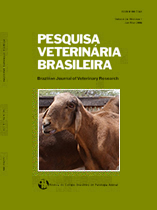 |
|
|
|
Year 2017 - Volume 37, Number 2
|

|
Relationship between adiposity, energy profile, inflammatory proteins and osteoarticular lesions in young horses on different rearing systems, 37(2):115-120
|
ABSTRACT.- Amaral L.A., Marchiori M., Moraes B.S., Finger I., Dos Santos R.S. & Nogueira C.E.W. 2017. [Relationship between adiposity, energy profile, inflammatory proteins and osteoarticular lesions in young horses on different rearing systems.] Relação entre adiposidade, perfil energético, proteínas inflamatórias e lesões osteoarticulares em equinos jovens sobre diferentes sistemas de criação. Pesquisa Veterinária Brasileira 37(2):115-120. Departamento de Clinicas, Faculdade de Veterinária, Universidade Federal de Pelotas, Campus Universitário s/n, Pelotas, RS 96010-900, Brazil. E-mail: lo1amaral@gmail.com
High carbohydrate diets are increasingly used in horse rearing systems. This can result in weight gain and fat accumulation in young horses. There is a growing incidence of juvenile osteoarthritis and other inflammatory conditions in overweight young horses that undergo intense physical exercise. The aim of this study was to associate corporal adiposity with energy profile, serum concentration of acute phase proteins and presence of osteo-articular lesion in the tarsal region of young horses raised in two different rearing systems: intensive system and extensive system. We evaluated 40 young horses 18 months old, 23 of them were females and 17 were males. Twenty horses were raised in the extensive rearing system and twenty horses were raised in intensive rearing system. Blood samples were collected for biochemical analysis and protein electrophoresis. Fat deposition on the crest of the neck, peritoneum and tailhead was measured by ultrasonography. Radiographic examination of the left tarsus was performed in 17 horses of the farm rearing system and in nine horses of the extensive rearing system. We observed higher levels of total cholesterol, LDL, glucose, serum amyloid A (SAA), transferrin, haptoglobin, acid glycoprotein and unidentified protein 23Kda in horses of the intensive system. These horses also showed higher fat deposition on the crest of the neck, peritoneum and tailhead than horses raised on extensive system. All horses on the intensive system group that underwent radiographic examination had lesions compatible with juvenile osteoarthritis while only 23% of the animals of the extensive system group showed such changes. With Fisher’s exact test we observed that horses of the intensive rearing system are 105% more likely to develop osteoarthritis than horses of the extensive rearing system. With the Pearson correlation test we found a positive correlation between fat deposition on the crest of the neck and degree of articular injury. Fat deposition on the crest of the neck also showed a positive correlation with serum levels of LDL, glucose, acid glycoprotein, haptoglobin, transferrin and SAA. The SAA correlated with the thickness of retroperitoneal fat. There was a positive correlation between retroperitoneal fat deposition and presence of osteoarticular abnormalities. In conclusion, fat deposition on the crest of the neck has a correlation with energetic profile changes, cute phase proteins changes and with articular injuries. Levels of glucose, LDL cholesterol, acid glycoprotein, haptoglobin, ceruloplasmin, transferrin and SAA have a correlation with fat deposition on the crest of the neck. In addition, young horses of the intensive rearing system are 105% more likely to have chronic degenerative joint lesions compatible with juvenile osteoarthritis than horses of the extensive rearing system. |
| |
|
|
| |
|
 |